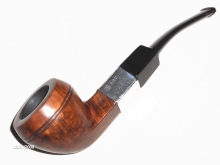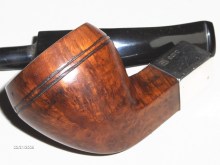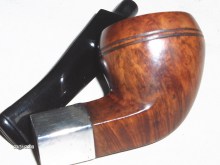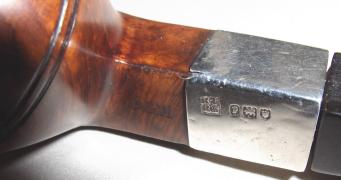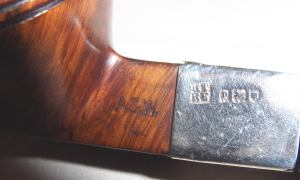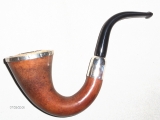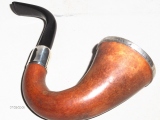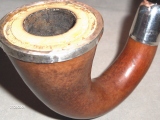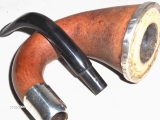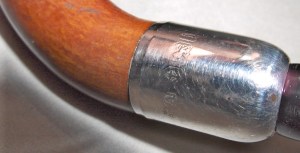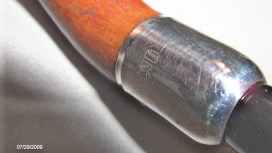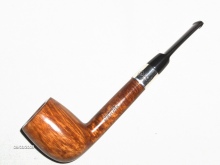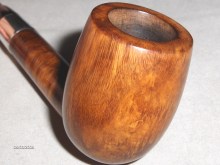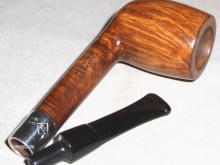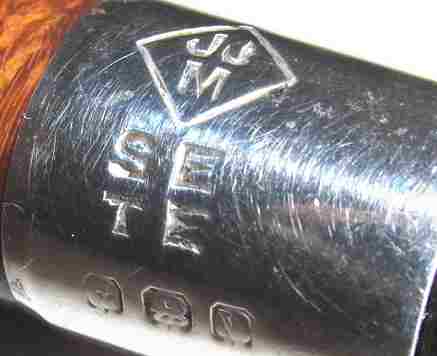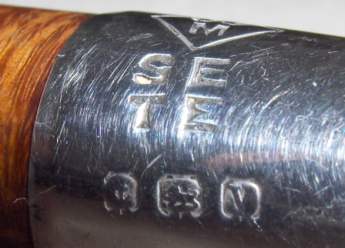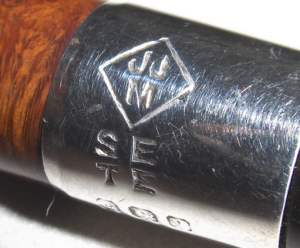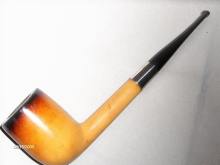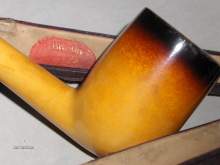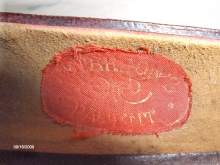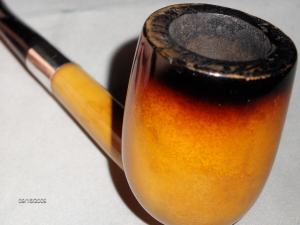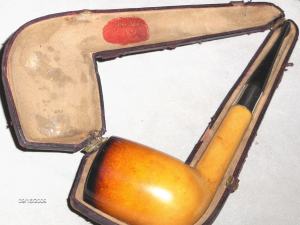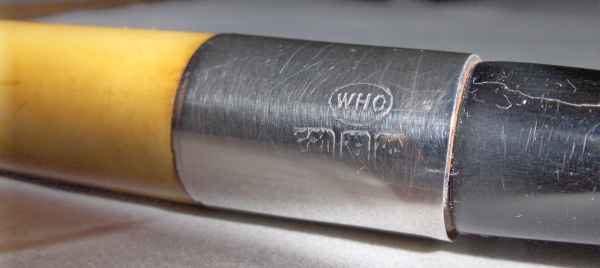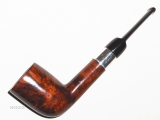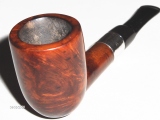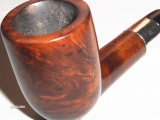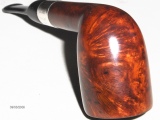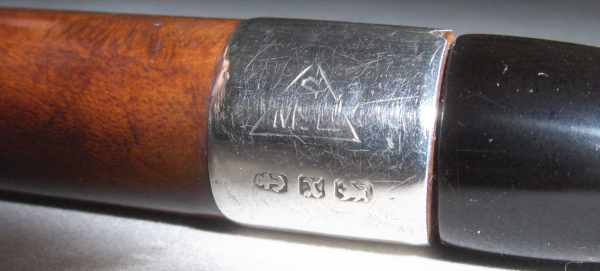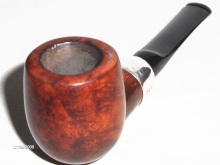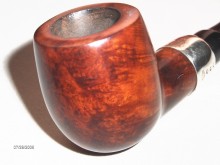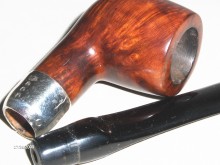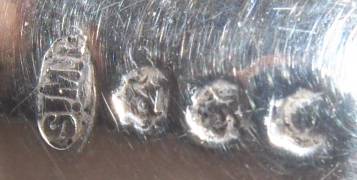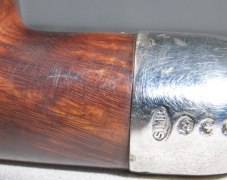by Piero
Eduardo and Giorgio Busetto
|
click on images to enlarge
A PIPE COLLECTION WITH SILVER COMPLEMENTS
A pipe for tobacco smoking typically consists of
a small chamber (the bowl) for the combustion of the tobacco to
be smoked and a thin stem (shank) that ends in a mouthpiece (the
bit).
Pipes can range from the very simple machine-made briar pipe to
highly-prized handmade and artful implements created by renowned
pipemakers which are often very expensive collector's items.
The stem needs a long channel of constant position and diameter
running through it, and this is difficult to carve out of a
pre-existing block. Because it is molded rather than carved,
clay may make up the entire pipe or just the bowl, but most
other materials have stems made separately and detachable.
In this page I present some pipes of my collection with a silver
band connecting the bowl to the detachable stem.
Briar pipe marked A&W., saddle bent bulldog shape
with large sterling silver band.
The bulldog shape is distinguished by its diamond-shaped bowl
and shank and usually a couple of lines cut around the widest
part of the bowl. Briar is cut from the root burl of the tree
heath (Erica arborea), which is native to the rocky and sandy
soils of the Mediterranean region.
The silver band was hallmarked in the London Assay Office, date
1910, maker's mark RT over RF into a rectangle, corresponding to
Robert Tucker & Reginald Fowles, plate workers. Mark entered on
4th June 1895 by Reginald Fowler. The mark was used by Tucker,
Fowler & Co listed (1897, 1913) at 20 Cheapside, EC, London as
Egyptian cigarettes importers. In 1920 they were listed at
various London addresses as cigar importers, cigarette
manufacturers, tabacconists and briar pipe makers.
Pipe's dimensions:
bowl: long 40mm /1.5748 in. - high 44mm / 1.7322 in.
total lenght: 138mm / 5.4330 in.
weight: 35gr / 1.2345 ounces.
Gourd and meerschaum pipe, calabash shape, with sterling
silver mount.
The calabash pipe consists of a downward curve that ends with an
upcurve where the bowl sits.
The silver mount was hallmarked in the Birmingham Assay Office, date
1908. Maker's mark JA in two conjoined circles, belonging to
James Aitchison (possibly), an Edinburgh silversmith and
retailer. Aitchison registered his mark in Edinburgh, London and
(possibly) Birmingham Assay Offices. An additional aluminum ring
is on the rim of the bowl.
Pipe's dimensions:
bowl: long 44mm / 1.7322 in. - high 65mm / 2.5590 in.
total lenght: 144mm / 5.6692 in.
weight: 44gr / 1.5520 ounces
Briar pipe, saddle-bit Lumberman shape with large
sterling silver band.
The stem is marked J. James over Manchester.
Lumberman is one of the numerous variations of the Billiard
shape, the most popular in briar pipes. The Lumberman has a long
oval shank with a short taper bit (mouthpiece).
The silver band was hallmarked in the Birmingham Assay Office, date
1920, maker's mark "SE over TE" belonging to Samuel H. Evans &
Thomas H. Evans, 24 Old Millgate, Manchester. This mark was
registered in 1904 as "Tobacco Merchants" in Chester Assay
Office. The silver band is also marked "JJ over M" into a
diamond (possibly an un-registered mark of the pipe's maker)
Pipe's dimensions:
bowl: long 34mm /1.3385 in. - high 47mm / 1.8503 in.
total lenght: 151mm / 5.9448 in.
weight: 33gr / 1.1640 ounces
Peterson's "Patent" Meerschaum pipe, huge Liverpool shape
with sterling silver mount and original case box.
The Liverpool is another of the numerous variation of the
Billiard shape. It has a long shank and a short taper bit (mouthpiece).
The "Patent" production was between the years of Peterson's
formation until the expiration of its patent or rather since
1875 through approximately 1910.
Meerschaum (means "sea foam") is a very special mineral found
from 30 to 450 feet below the surface of the earth near the town
of Eskisehir, Turkey.
The silver band was hallmarked in the Birmingham Assay Office, date
not identified. Maker's mark "WHC" into an oval, belonging to
W.H. Carrington & Co, 53 Thomas Street, Manchester. This mark
was registered in Chester in 1888 c. and in Birmingham Assay
Office on April 24, 1891. The firm was classified by Chester
Assay Office as "Tabacconist and fancy goods dealers".
Pipe's dimensions:
bowl: long 43.5mm /1.7126 in. - high 43.5mm /1.7126 in.
total lenght: 187mm / 7.3622 in.
weight: 56gr / 1.9753 ounces
Samuel McLardy & Co briar pipe, saddle bit cutty shape
with large sterling silver band (a saddle bit pipe has a
flattened part for easier gripping).
The silver band was hallmarked in the Birmingham Assay Office, date
1897. Maker's mark "S over McL" into a triangle, belonging to
Samuel McLardy & Co, 16 Miller Street, Manchester, Tobacco Pipe
Manufacturer and Silversmith, since 1865 to 1930.
Pipe's dimensions:
bowl: long 30mm /1.1811 in. - high 46mm / 1.8110 in.
total lenght: 129mm / 5.0787 in.
weight: 28gr / 0.9876 ounces
Samuel McLardy & Co briar pipe, "Army mounted" saddle-bit
slim billiard shape with sterling silver mount.
The "Army" mount is rounded off at one end and takes a special
bit that tapers into it. The idea is that the bit can be easily
removed to eliminate the risk of breaking the peg. It also
allows longer or shorter mouthpieces to be used readily. The "Army"
mount is particularly popular with sailors.
The silver mount was hallmarked in the London Assay Office, date
1916. Maker's mark "S.McL" into an oval, belonging to Samuel
McLardy & Co, Manchester, where it was listed (1914) as Tobacco
Pipe Manufacturer and importer of Tabacconists fancy goods. The
firm was listed in London as Wholesale Jewellers with London,
Birmingham and Sheffield warehousemen. Different marks inside a
triangle (see above) were registered by this firm in Chester and
Birmingham.
Pipe's dimensions:
bowl: long 32mm /1.2598 in. - high 40mm / 1.5748 in.
total lenght: 130mm / 5.1181 in.
weight: 25gr / 0.8818 ounces
|
Piero Eduardo and Giorgio Busetto
- 2009 -
|
|
 ASSOCIATION OF SMALL COLLECTORS OF ANTIQUE SILVER
ASSOCIATION OF SMALL COLLECTORS OF ANTIQUE SILVER